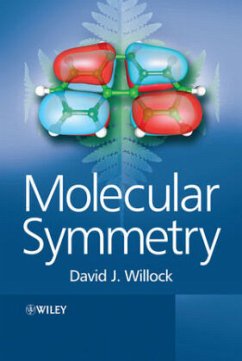Symmetry in Chemistry carefully introduces the subject by combining symmetry with spectroscopy in a clear and accessible manner. Beginning with an introduction to symmetry in nature and chemistry, the text goes on to examine point groups, the interaction of light with molecules, electronic spectra of transition metal complexes with a final chapter on symmetry and the spectra of complexes. Each chapter introduces the subject gradually and ends with a series of self-test questions to enhance student understanding.
Symmetry and group theory provide us with a formal method for thedescription of the geometry of objects by describing the patternsin their structure. In chemistry it is a powerful method thatunderlies many apparently disparate phenomena. Symmetry allows usto accurately describe the types of bonding that can occur betweenatoms or groups of atoms in molecules. It also governs thetransitions that may occur between energy levels in molecularsystems, which in turn allows us to predict the absorptionproperties of molecules and hence their spectra.
Molecular Symmetry lays out the formal language usedin the area using illustrative examples of particular moleculesthroughout. It then applies the ideas of symmetry to describemolecular structure, bonding in molecules and consider theimplications in spectroscopy.Topics covered include:
Symmetry elements
Symmetry operations and products of operations
Point groups used with molecules
Point group representations, matrices and basis sets
Reducible and irreducible representations
Applications in vibrational spectroscopy
Symmetry in chemical bonding
Molecular Symmetry is designed to introduce the subjectby combining symmetry with spectroscopy in a clear and accessiblemanner. Each chapter ends with a summary of learning points, aselection of self-test questions, and suggestions for furtherreading. A set of appendices includes templates for paper modelswhich will help students understand symmetry groups.
Molecular Symmetry is a must-have introduction to thisfundamental topic for students of chemistry, and will also find aplace on the bookshelves of postgraduates and researchers lookingfor a broad and modern introduction to the subject
Symmetry and group theory provide us with a formal method for thedescription of the geometry of objects by describing the patternsin their structure. In chemistry it is a powerful method thatunderlies many apparently disparate phenomena. Symmetry allows usto accurately describe the types of bonding that can occur betweenatoms or groups of atoms in molecules. It also governs thetransitions that may occur between energy levels in molecularsystems, which in turn allows us to predict the absorptionproperties of molecules and hence their spectra.
Molecular Symmetry lays out the formal language usedin the area using illustrative examples of particular moleculesthroughout. It then applies the ideas of symmetry to describemolecular structure, bonding in molecules and consider theimplications in spectroscopy.Topics covered include:
Symmetry elements
Symmetry operations and products of operations
Point groups used with molecules
Point group representations, matrices and basis sets
Reducible and irreducible representations
Applications in vibrational spectroscopy
Symmetry in chemical bonding
Molecular Symmetry is designed to introduce the subjectby combining symmetry with spectroscopy in a clear and accessiblemanner. Each chapter ends with a summary of learning points, aselection of self-test questions, and suggestions for furtherreading. A set of appendices includes templates for paper modelswhich will help students understand symmetry groups.
Molecular Symmetry is a must-have introduction to thisfundamental topic for students of chemistry, and will also find aplace on the bookshelves of postgraduates and researchers lookingfor a broad and modern introduction to the subject
"The work will prove to be a popular choice as a textbook or as anadditional resource for group theory and advanced inorganicchemistry courses." ( CHOICE , November 2009)
"A major strength of this book is its accessibility to thepractically and conceptually minded chemist; the reader is led intothe subject through strong visual presentation of the ideas andalthough the mathematics is by no means ignored, it is presentedwithin an applied context." ( The Higher Education AcademyPhysical Sciences Centre Reviews , May 2009)
"A major strength of this book is its accessibility to thepractically and conceptually minded chemist; the reader is led intothe subject through strong visual presentation of the ideas andalthough the mathematics is by no means ignored, it is presentedwithin an applied context." ( The Higher Education AcademyPhysical Sciences Centre Reviews , May 2009)








